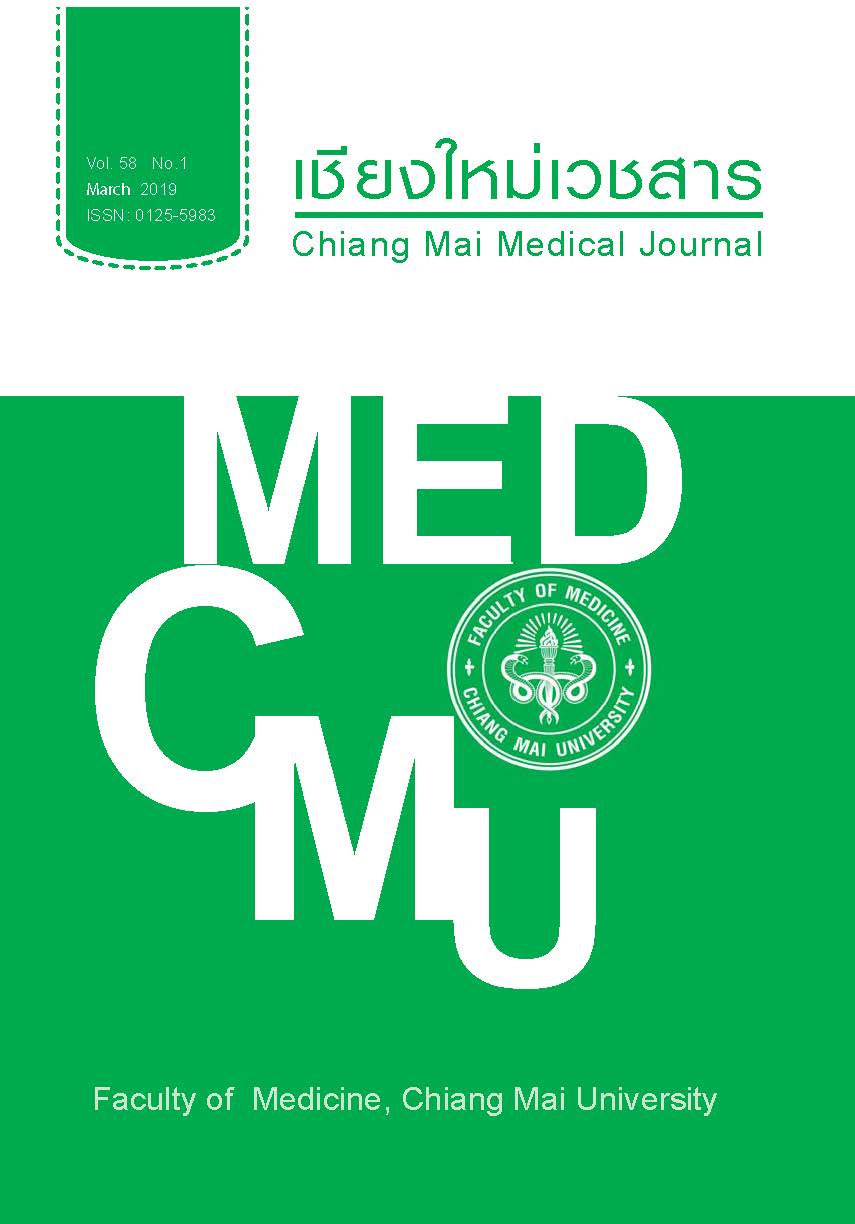Handgrip strength of community-dwelling elderly in Nakhon Ratchasima Province, Thailand
Keywords:
HGS, Thai elderly, BMI, CommunityAbstract
Objective To investigate handgrip strength (HGS) in Thai elderly living in Nakhon Ratchasima Province, Thailand, and to examine factors related to HGS.
Methods In this is a cross-sectional analytical study, participants were elderly individuals (age >60 years) living in Nakhon Ratchasima, Thailand. Demographic characteristics, anthropometric measurements, and Barthel Activities of Daily Living index (ADL) were recorded. Assessment of grip strength of the dominant hand was conducted following standardized testing procedures of the American Society of Hand Therapists.
Results The mean age (±SD) of the 491 participants was 69.15±6.86 years. The mean HGS for male participants was significantly higher than for females (24.93±7.45 vs 16.17±4.82, p<0.001), but there was a significant decline in HGS with age in both genders (r=-0.310, p<0.01). Dividing participants by BMI found that normal and overweight individuals had a higher HGS than underweight participants (p<0.001).
Conclusion As age increases, the HGS of both males and females declines. Elderly males have a higher HGS than females. Elderly (age ≥ 60 years) of both genders have a statistically significantly higher HGS than underweight individuals.
References
2. Danielewicz AL, Barbosa AR, Del Duca GF. Nutritional status, physical performance and functional capacity in an elderly population in southern Brazil. Rev Assoc Med Bras (1992). 2014;60:242-8.
3. Rantanen T, Volpato S, Ferrucci L, Heikkinen E, Fried LP, Guralnik JM. Handgrip strength and cause-specific and total mortality in older disabled women: exploring the mechanism. J Am Geriatr Soc. 2003;51:636-41.
4. Norman K, Schutz T, Kemps M, Josef Lubke H, Lochs H, Pirlich M. The Subjective Global Assessment reliably identifies malnutrition-related muscle dysfunction. Clin Nutr. 2005;24:143-50.
5. Matos LC, Tavares MM, Amaral TF. Handgrip strength as a hospital admission nutritional risk screening method. Eur J Clin Nutr. 2007;61:1128-35.
6. Vaz M, Thangam S, Prabhu A, Shetty PS. Maximal voluntary contraction as a functional indicator of adult chronic undernutrition. Br J Nutr. 1996;76:9-15.
7. Rantanen T, Guralnik JM, Foley D, Masaki K, Leveille S, Curb JD, et al. Midlife handgrip strength as a predictor of old age disability. JAMA. 1999;281:558-60.
8. Taekema DG, Gussekloo J, Maier AB, Westendorp RG, de Craen AJ. Handgrip strength as a predictor of functional, psychological and social health. A prospective population-based study among the oldest old. Age Ageing. 2010;39:331-7.
9. Cesari M, Onder G, Russo A, Zamboni V, Barillaro C, Ferrucci L, et al. Comorbidity and physical function: results from the aging and longevity study in the Sirente geographic area (ilSIRENTE study). Gerontology. 2006;52:24-32.
10. Park SW, Goodpaster BH, Strotmeyer ES, de Rekeneire N, Harris TB, Schwartz AV, et al. Decreased muscle strength and quality in older adults with type 2 diabetes: the health, aging, and body composition study. Diabetes. 2006;55:1813-8.
11. Silventoinen K, Magnusson PK, Tynelius P, Batty GD, Rasmussen F. Association of body size and muscle strength with incidence of coronary heart disease and cerebrovascular diseases: a population-based cohort study of one million Swedish men. Int J Epidemiol. 2009;38:110-8.
12. Syddall H, Cooper C, Martin F, Briggs R, Aihie Sayer A. Is grip strength a useful single marker of frailty? Age and ageing. 2003;32:650-6.
13. Cawthon PM, Fox KM, Gandra SR, Delmonico MJ, Chiou CF, Anthony MS, et al. Do muscle mass, muscle density, strength, and physical function similarly influence risk of hospitalization in older adults? J Am Geriatr Soc. 2009;57:1411-9.
14. Kerr A, Syddall HE, Cooper C, Turner GF, Briggs RS, Sayer AA. Does admission grip strength predict length of stay in hospitalised older patients? Age and ageing. 2006;35:82-4.
15. Sasaki H, Kasagi F, Yamada M, Fujita S. Grip strength predicts cause-specific mortality in middle-aged and elderly persons. Am J Med. 2007;120:337-42.
16. Aekplakorn W, editor. National Health Examination Survey, NHES V; 2014, Thailand. Bangkok: Graphic and Design; 2016.
17. Yamane T. Statistics, An Introductory Analysis. 3rd ed. New York: Harper and Row; 1973.
18. Chilima DM, Ismail SJ. Anthropometric characteristics of older people in rural Malawi. Eur J Clin Nutr. 1998; 52:643-9.
19. World Health Organization.int (homepage on the internet). Geneva: BMI classification (updated 2018 June 6; cited 2018 June 7). Available from: http://www.who.int
20. Liu W, Unick J, Galik E, Resnick B. Barthel Index of activities of daily living: item response theory analysis of ratings for long-term care residents. Nurs Res. 2015;64:88-99. doi: 10.1097/NNR.0000000000000072.
21. American Society of Hand T. Clinical assessment recommendations. Chicago, Ill: second edition published in 1992.
22. Skelton DA, Greig CA, Davies JM, Young A. Strength, power and related functional ability of healthy people aged 65-89 years. Age and ageing. 1994;23:371-7.
23. Hu H, Li Z, Yan J, Wang X, Xiao H, Duan J, et al. Anthropometric measurement of the Chinese elderly living in the Beijing area. Int J Ind Ergon. 2007;37:303-11.
24. Coqueiro RdS, Barbosa AR, Borgatto AF. Anthropometric measurements in the elderly of Havana, Cuba: Age and sex differences. Nutrition. 2009;25:33-9.
25. Nurul Shahida MS, Siti Zawiah MD, Case K. The relationship between anthropometry and handgrip strength among elderly Malaysians. Int J Ind Ergon. 2015;50:17-25.
26. Perissinotto E1, Pisent C, Sergi G, Grigoletto F; ILSA Working Group (Italian Longitudinal Study on Ageing) Anthropometric measurements in the elderly: age and gender differences. Br J Nutr. 2002;87:177-86.
27. Lexell J. Human aging, muscle mass, and fiber type composition. J Gerontol A Biol Sci Med Sci. 1995;50 Spec No:11-6.
28. Grimby G. Muscle performance and structure in the elderly as studied cross-sectionally and longitudinally. J Gerontol A Biol Sci Med Sci. 1995;50 Spec No:17-22.
29. Chilima DM, Ismail SJ. Nutrition and handgrip strength of older adults in rural Malawi. Public Health Nutr. 2001;4:11-7.











